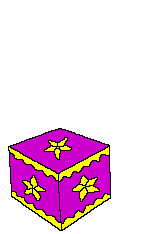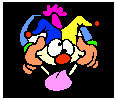





 A Clown's Prayer
A Clown's Prayer
As I stumble through this life,
help me to create more laughter than tears,
dispense more cheer than gloom,
spread more cheer than despair.
Never let me become so indifferent,
that I will fail to see the wonders in the eyes of a child,
or the twinkle in the eyes of the aged.
Never let me forget that my total effort is to cheer people,
make them happy, and forget momentarily,
all the unpleasantness in their lives.
And in my final moment,
may I hear You whisper:
"When you made My people smile,
you made me smile."
-Anonymous-
What's it All About, Alphie?
Daffynition
Clown, "a familiar comic character of pantomime and circus, known by his distinctive makeup and costume, ludicrous antics and buffoonery, whose purpose is to induce hearty laughter. The clown usually performs a set routine characterized by broad, graphic humor, absurd situations and vigorous physical action."
(according to Encyclopedia Britannica)
 Long Ago
Long Ago
The earliest ancestors of the clown flourished in ancient Greece and were bald-headed, padded buffoons.They often performed a parody of more serious characters, sometimes pelting the spectators with nuts. Some say clowning can be traced as far back as 3000 B.C., but the professional comic actor did not emerge
until the Middle Ages. Throughout this time, most cultures have had some form of clown among them. Jesters, Aztec fools, dwarf clowns and hunch-backed buffoons to name a few. Most Native American tribes had some type of clown and they were even believed to be able to cure some forms of disease.
Jest Because Clowns performing as court jesters usually had great freedom of speech. They were often the only ones to speak out against the rulers and affect policy changes, through their humor. Chinese emporer Shih Huang-Ti oversaw the building of the Great Wall of China in 300 BC. Thousands of laborers were killed during construction. Thousands more would have lost their lives had he followed through with the painting of it. Yu Sze, his jester, criticized his plan and jokingly convinced him to abandon it. Today, Yu Sze is remembered as a national hero.
 Name That Tune
Name That Tune
It's not clear where the custom of using a "stage name" began. some think it originated with Emmett Kelly's "Weary Willie" character. Another idea is that non-circus clowns are more desirable to hire as "Jingles" than John Doe. A special name helps to build the fantasy nature of the clown and puts the actor into character when clowning. Most circus clowns do not use stage names.
 A Woman's Place
A Woman's Place
Amelia Butler was the first female circus clown that is recorded
in history. She played a feminine clown in 1858 while touring
with a show called Nixon's Great Amerian Circus and Kemp's Mammoth English Circus.
 The "Caste" of Characters
The "Caste" of Characters
White Face
There are three basic types of clowns. The white face is said to have been introduced with the character of Pierrot, a French clown with a bald head and flour-whitened face. He first appeared in the latter part of the 17th century. The white face clown is typically the straight clown in skits with makeup which has a base of white grease paint. A straight clown will usually be the one acting very serious, but who falls prey to the brunt of the joke. The white face clown's costume tends to be more formal in that the colors and design will flow throughout. The colors are less likely to be gaudy and mis-matched as in the other clown
types.
The makeup of the white face clown is typically simple to look at and will highlight the natural features of the face (i.e., eyes, cheeks, lips, nose, etc.) The variations of a white face clown are endless and there are no specific guidelines other than
the basic white face. White face clowns are at the top of the hierarchy and can play tricks on any of the other clowns.
 Auguste
Auguste
In the 1860's, a low-comedy buffoon appeared under the name of Auguste. He had a big nose, baggy clothes, large shoes and rotten manners. He worked with a white face clown and always spoiled the latter's tricks by appearing at inappropriate times to foul things up. The Auguste clown tends to be the silly clown and
his makeup is made up of bright flesh tones. The silly clown will
usually appear to not know what is going on in a skit, but they usually somehow escape the "blow off." The costume of the Auguste clown tends to be gaudy, less matched and very bright. Primary colors are most popular with this clown type.
The makeup is usually bright and exaggerates the clown's natural features (e.g.,large nose, big lips, over-sized eyes, etc.) Again, there are many variations and each clown has their own special characteristics.
 Character Clown
Character Clown
The character clown is just what you would think it is -- a character which is exaggerated into a clown. The most popular character clown is the Hobo or Tramp clown. The tramp clown characterization was created in 1874 by James McIntyre and Tom Heath. They based their characters on blackface minstrel clowns which is the origin of the white mouth used by tramp clowns. The Hobo usually has tattered clothes, a tattered hat, makeup which suggests a weeks worth of beard, a red nose and other exaggerated features.
Character clowns can be from all walks of life and some of the popular ones are police officers, women or babies. (Emmett Kelly and Red Skelton were two of my favorite character clowns.) Character clowns can play tricks on no one. They are at the bottom of the heirarchy.
Clowning Around
Did you know that . . . .???
The first clown can be traced back to 3000 B.C.
Clowns are known as "Joeys" in honor of Joseph Grimaldi, "father of modern clowning."
A clown's face is their trademark and cannot be copied. His costume and act, however, may be.
To trademark a clown's face, a photo is sent in to the Clown Character Registry where it is then painted on a goose egg and kept.
The tradition of painting the face on an egg began in the 1500's, when clowns would paint their own faces on them to remember how to apply their makeup.
Between 50,000 and 80,000 clowns exist in the world today.
Bozo's shoe size is 83AAA.
